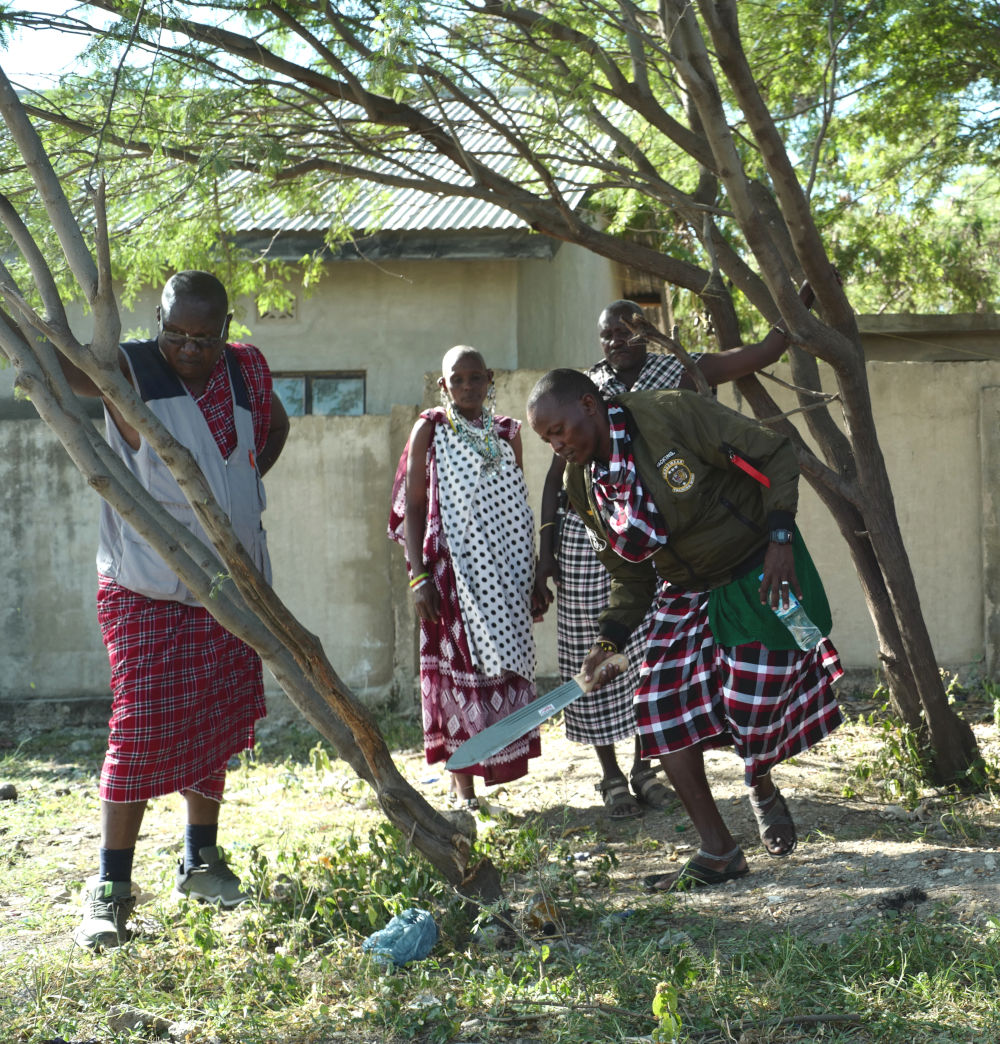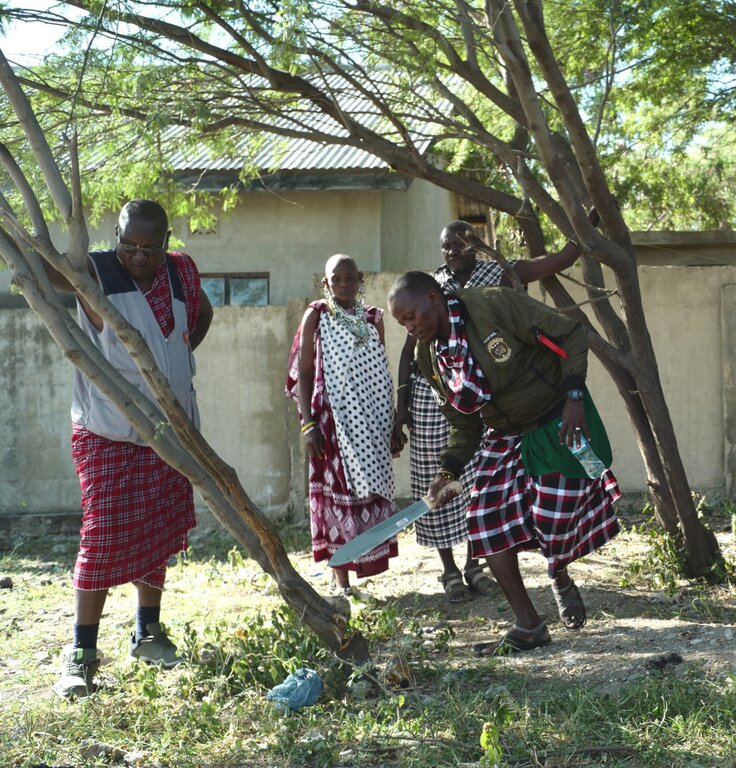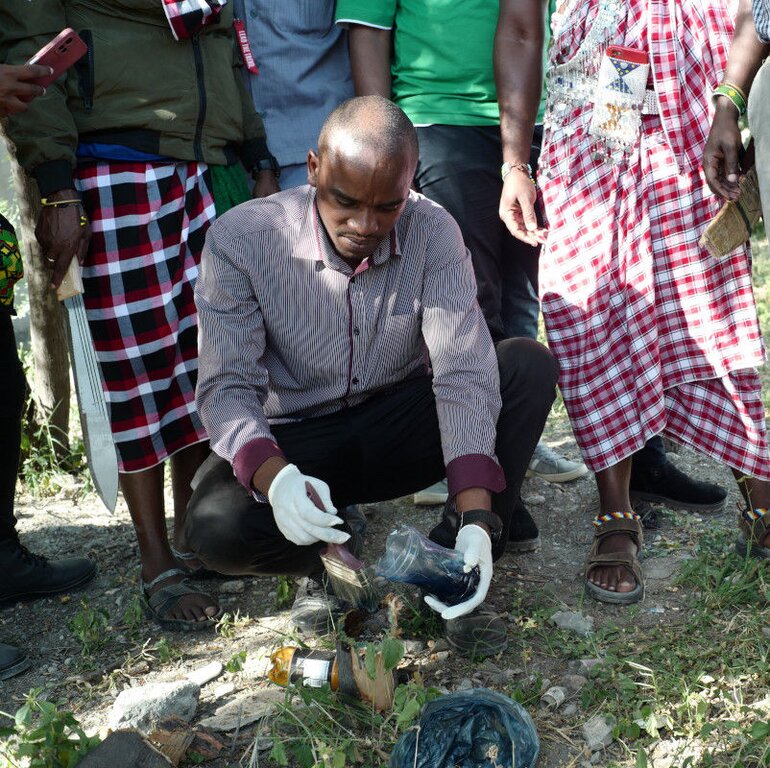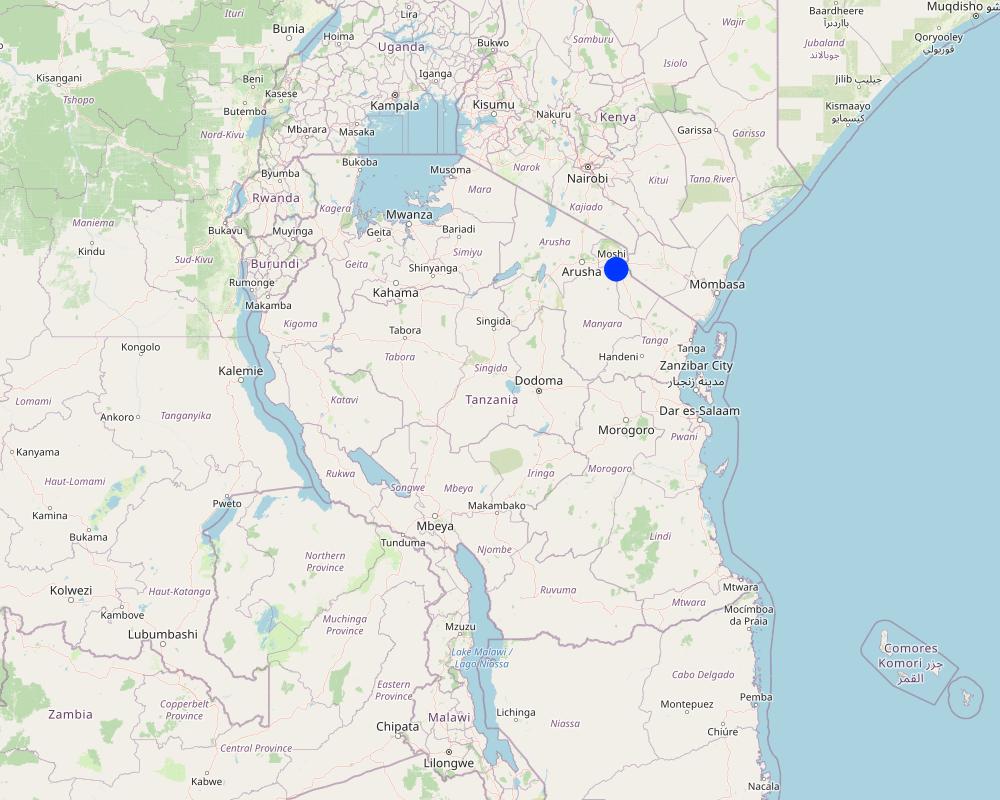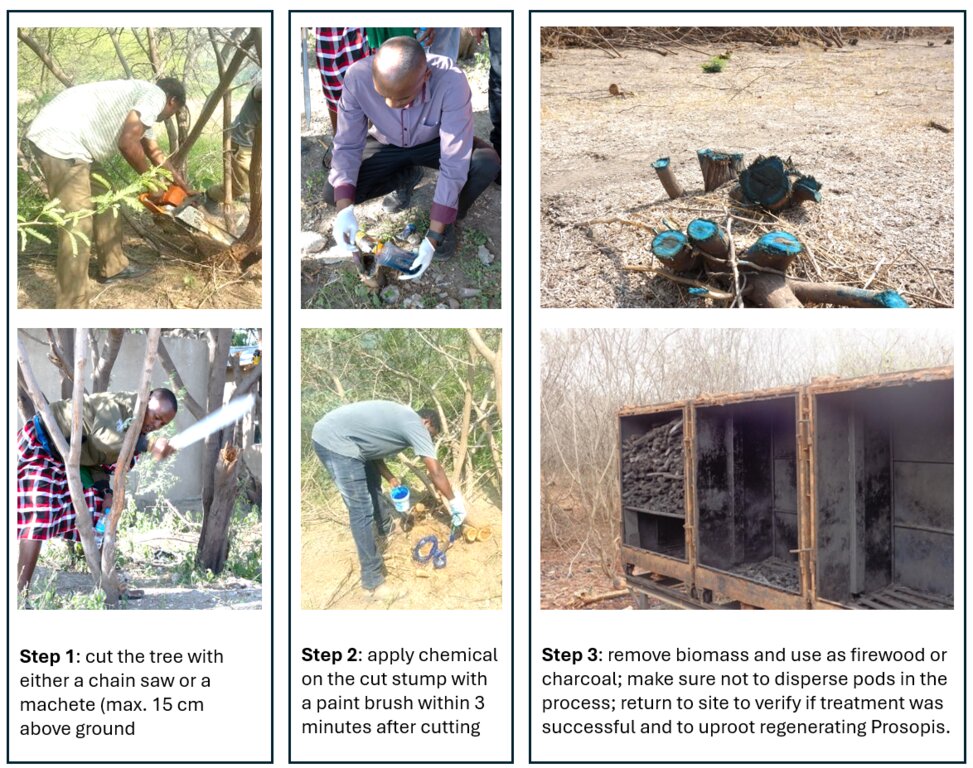Cut stump [Tanzania, United Republic of]
- Creation:
- Update:
- Compiler: John Mbwambo
- Editors: Albrecht Ehrensperger, Beatrice Otieno
- Reviewers: Christian Hergarten, Albrecht Ehrensperger
Kukata visiki
technologies_6207 - Tanzania, United Republic of
View sections
Expand all Collapse all1. General information
1.2 Contact details of resource persons and institutions involved in the assessment and documentation of the Technology
Name of project which facilitated the documentation/ evaluation of the Technology (if relevant)
R4D Woody WeedsName of the institution(s) which facilitated the documentation/ evaluation of the Technology (if relevant)
Tanzania Forestry Research Institute (TAFORI) - Tanzania, United Republic ofName of the institution(s) which facilitated the documentation/ evaluation of the Technology (if relevant)
CDE Centre for Development and Environment (CDE Centre for Development and Environment) - SwitzerlandName of the institution(s) which facilitated the documentation/ evaluation of the Technology (if relevant)
CABI Switzerland (CABI Switzerland) - Switzerland1.3 Conditions regarding the use of data documented through WOCAT
The compiler and key resource person(s) accept the conditions regarding the use of data documented through WOCAT:
Yes
1.4 Declaration on sustainability of the described Technology
Is the Technology described here problematic with regard to land degradation, so that it cannot be declared a sustainable land management technology?
No
Comments:
It is an SLM technology and is being tested for out-scaling in areas invaded by Prosopis juliflora
2. Description of the SLM Technology
2.1 Short description of the Technology
Definition of the Technology:
The cut stump technology is probably the most effective means of killing mature Prosopis trees using the herbicide Triclon with active ingredients Triclopyr 480g/l . Stems are cut with a chainsaw as close to the ground as possible and the herbicide is applied to the stump within three minutes of cutting using a paintbrush. The young plants with less than 2 cm root collar diameter should be uprooted by hand. The treatment is repeated after three months on resprouting stumps.
2.2 Detailed description of the Technology
Description:
The technology is highly relevant and effective for controlling the invasion of Prosopis spp. in both agricultural and grassland areas where the species is considered problematic. It is particularly suitable for dry regions prone to Prosopis invasions, especially those experiencing drought periods of more than four months, which allow the herbicide to take significant effect. To avoid chemical contamination, the technology should only be applied in areas located more than 200 meters away from water sources.
This method requires simple tools to cut trees efficiently, with a chainsaw being recommended for the task. However, in areas where infestations cover less than 20 percent of the land, simpler tools such as machetes can be used. Trees should be cut as close to the ground as possible (no more than 15 cm stump height), and herbicide should be applied to the stump within three minutes of cutting. The treatment should be carried out during the dry season, ensuring no rainfall is expected within a month to allow for complete absorption of the herbicide.
A minimum of two people equipped with proper protective clothing is required for this operation: one to cut the trees and another to apply the herbicide and clear the cut branches. The herbicide, typically Triclopyr, is often mixed with diesel at a 1:50 ratio. A follow-up application is crucial to target any trees that were not completely killed during the initial treatment.
Herbicides can be ordered from Arysta Co. Ltd in Tanzania at a cost of TZS 1,000,000 (USD 430) per 20 liters. The advantages of using this technology include its effectiveness in killing the trees and the ability to utilize the cut branches as fuelwood or for making Prosopis charcoal. However, the major drawbacks include limited information leading to scepticism among land users regarding the health risks and potential long-term effects on soil quality, as well as the limited availability of the herbicide in local agro-stores.
2.3 Photos of the Technology
General remarks regarding photos:
The photograph has been added later than the documentation has taken place.
2.5 Country/ region/ locations where the Technology has been applied and which are covered by this assessment
Country:
Tanzania, United Republic of
Region/ State/ Province:
Kilimanjaro
Further specification of location:
Kahe
Specify the spread of the Technology:
- applied at specific points/ concentrated on a small area
Is/are the technology site(s) located in a permanently protected area?
No
Map
×2.6 Date of implementation
Indicate year of implementation:
2017
If precise year is not known, indicate approximate date:
- less than 10 years ago (recently)
2.7 Introduction of the Technology
Specify how the Technology was introduced:
- during experiments/ research
Comments (type of project, etc.):
The technology was introduced through experimentation during the implementation of the Woody Weeds Project. For more details visit www.woodyweeds.org
3. Classification of the SLM Technology
3.1 Main purpose(s) of the Technology
- improve production
- reduce, prevent, restore land degradation
- conserve ecosystem
- preserve/ improve biodiversity
- create beneficial social impact
3.2 Current land use type(s) where the Technology is applied
Land use mixed within the same land unit:
Yes
Specify mixed land use (crops/ grazing/ trees):
- Agro-pastoralism (incl. integrated crop-livestock)

Cropland
- Annual cropping
Annual cropping - Specify crops:
- cereals - maize
- vegetables - other
Annual cropping system:
Continuous vegetables
Is intercropping practiced?
Yes
If yes, specify which crops are intercropped:
Maize and tomato, Maize and black nightshade
Is crop rotation practiced?
Yes
If yes, specify:
Maize with tomato, black nightshade with bell peppers

Grazing land
Extensive grazing:
- Transhumant pastoralism
Is integrated crop-livestock management practiced?
Yes
If yes, specify:
Livestock are released to graze around fenced farmlands or graze/feed on stalks left after harvests.
Products and services:
- meat
Species:
cattle - non-dairy beef
Count:
10
Comments:
Crop cultivation and grazing are rotated to avoid crop damage and sometimes cropland is fenced with thorny branches of Prosopis juliflora to deter livestock from accessing the crop fields.
3.3 Has land use changed due to the implementation of the Technology?
Has land use changed due to the implementation of the Technology?
- No (Continue with question 3.4)
Land use mixed within the same land unit:
Yes
Specify mixed land use (crops/ grazing/ trees):
- Agro-pastoralism (incl. integrated crop-livestock)

Cropland
- Annual cropping
Annual cropping system:
Continuous vegetables
Is intercropping practiced?
Yes
If yes, specify which crops are intercropped:
Maize and tomato, Maize and black nightshade
Is crop rotation practiced?
Yes
If yes, specify:
Maize with tomato, black nightshade with bell peppers

Grazing land
Extensive grazing:
- Transhumant pastoralism
Comments:
Crop cultivation and grazing are rotated to avoid crop damage and sometimes cropland is fenced with thorny branches of Prosopis juliflora to deter livestock from accessing the crop fields.
3.4 Water supply
Water supply for the land on which the Technology is applied:
- mixed rainfed-irrigated
Comments:
Cultivation of vegetables relies fully on irrigation. Water is obtained from shallow bore holes and pumped out to irrigate the fields.
3.5 SLM group to which the Technology belongs
- Weed control and management
3.6 SLM measures comprising the Technology

management measures
- M5: Control/ change of species composition
Comments:
The cut stump technology is considered a control of species composition because the intention is to remove or reduce the abundance of the invasive species and improve performance of desired native plant species.
3.7 Main types of land degradation addressed by the Technology

biological degradation
- Bs: quality and species composition/ diversity decline
Comments:
The technology controls and reduces the density of an invasive tree Prosopis juliflora on grazing land and cultivated fields.
3.8 Prevention, reduction, or restoration of land degradation
Specify the goal of the Technology with regard to land degradation:
- restore/ rehabilitate severely degraded land
Comments:
The land degradation is due to change of vegetation cover as a result of increasing abundance of an invasive tree.
4. Technical specifications, implementation activities, inputs, and costs
4.1 Technical drawing of the Technology
Technical specifications (related to technical drawing):
Stems of Prosopis should be cut very close to the ground (ca. 15 cm from the ground)
Author:
Albrecht Ehrensperger (based on photos from different authors)
Date:
03/07/2024
4.2 General information regarding the calculation of inputs and costs
Specify how costs and inputs were calculated:
- per Technology area
Indicate size and area unit:
0.01 Hectares
other/ national currency (specify):
Tanzanian Shilling
If relevant, indicate exchange rate from USD to local currency (e.g. 1 USD = 79.9 Brazilian Real): 1 USD =:
2400.0
Indicate average wage cost of hired labour per day:
20,000
4.3 Establishment activities
| Activity | Timing (season) | |
|---|---|---|
| 1. | Acquisition of Chemical (Triclon) | anytime of the year |
| 2. | Hiring a Chain Saw | anytime of the year |
| 3. | Cutting of stems | During dry season (normally January - March) |
| 4. | Chemical application using paint brush | Within five minutes after cutting the stems |
| 5. | Separating intertwined branches | Immediately after cutting the stems |
| 6. | Cleaning the area from thorns and small branches | Immediately after cutting the stems |
| 7. | 2nd treatments of stumps | Two months after chemical treatments and during dry season |
| 8. | 3rd treatment of stumps | After 6-8 months after 1st treatment and should be during dry season (normally September - October) |
| 9. | Removing regenerating Prosopis | Every three months after 1st treatment for 15 months |
Comments:
It is important to find out which chemical is registered for use in your area. Triclopyr was easy to use and very effective to kill trees with stem diameter > 5cm.
4.4 Costs and inputs needed for establishment
| Specify input | Unit | Quantity | Costs per Unit | Total costs per input | % of costs borne by land users | |
|---|---|---|---|---|---|---|
| Labour | Cutting of stems | Mandays | 2.0 | 20000.0 | 40000.0 | |
| Labour | Chemical application using paint brush | Mandays | 1.0 | 20000.0 | 20000.0 | |
| Labour | Separating intertwined branches | Mandays | 2.0 | 20000.0 | 40000.0 | |
| Labour | Removing small branches and debris | Mandays | 1.0 | 20000.0 | 20000.0 | |
| Equipment | Hiring a Chain saw | Hours | 8.0 | 4000.0 | 32000.0 | |
| Fertilizers and biocides | Triclon (480g/l Triclopyr) | Litres | 1.2 | 50000.0 | 60000.0 | |
| Total costs for establishment of the Technology | 212000.0 | |||||
| Total costs for establishment of the Technology in USD | 88.33 | |||||
If land user bore less than 100% of costs, indicate who covered the remaining costs:
R4D Woody Weeds Project
Comments:
The estimated costs is for an area covered with > 80 Prosopis juliflora. The technology has not yet been out-scaled. The main challenge with its adoption is the availability of the chemical Triclon.
4.5 Maintenance/ recurrent activities
| Activity | Timing/ frequency | |
|---|---|---|
| 1. | Uprooting regenerating Prosopis | after every three months |
| 2. | Chemical application | Every dry season up to 15 months |
Comments:
To ensure effective control it is important to uproot all regenerating Prosopis after every three months.
4.6 Costs and inputs needed for maintenance/ recurrent activities (per year)
| Specify input | Unit | Quantity | Costs per Unit | Total costs per input | % of costs borne by land users | |
|---|---|---|---|---|---|---|
| Labour | uprooting regenerating Prosopis | Mandays | 5.0 | 20000.0 | 100000.0 | |
| Fertilizers and biocides | Triclon (triclopyr 480g/L) | Litres | 0.6 | 50000.0 | 30000.0 | |
| Total costs for maintenance of the Technology | 130000.0 | |||||
| Total costs for maintenance of the Technology in USD | 54.17 | |||||
If land user bore less than 100% of costs, indicate who covered the remaining costs:
R4D Woody Weeds
Comments:
After every three months, uprooting of all regenerating Prosopis should be done before they develop deep roots and start competing with desired plants.
4.7 Most important factors affecting the costs
Describe the most determinate factors affecting the costs:
(i) Availability of labor during farming seasons
(ii) Distance from and availability of agro-chemical stores
(iii) Size of Prosopis trees
(iv) Length of dry and wet seasons (long wet season makes many seed of Prosopis to germinate and long dry season makes it difficult to work out under the sun)
5. Natural and human environment
5.1 Climate
Annual rainfall
- < 250 mm
- 251-500 mm
- 501-750 mm
- 751-1,000 mm
- 1,001-1,500 mm
- 1,501-2,000 mm
- 2,001-3,000 mm
- 3,001-4,000 mm
- > 4,000 mm
Specify average annual rainfall (if known), in mm:
400.00
Specifications/ comments on rainfall:
Extended dry seasons from September to mid-March. Bi-annual rainfall, with most rain falling from April to Mid and short rains from Mid November to December.
Indicate the name of the reference meteorological station considered:
TPC Sugar Manufacturing Company
Agro-climatic zone
- semi-arid
The area is very dry and agriculture is only possible through irrigation. Temperatures are very high during the day, at about 30 degrees Celcius. However, domestic animals such as cattle, goats, and sheep thrive fairly well in the area and there is very good hay during rainy seasons.
5.2 Topography
Slopes on average:
- flat (0-2%)
- gentle (3-5%)
- moderate (6-10%)
- rolling (11-15%)
- hilly (16-30%)
- steep (31-60%)
- very steep (>60%)
Landforms:
- plateau/plains
- ridges
- mountain slopes
- hill slopes
- footslopes
- valley floors
Altitudinal zone:
- 0-100 m a.s.l.
- 101-500 m a.s.l.
- 501-1,000 m a.s.l.
- 1,001-1,500 m a.s.l.
- 1,501-2,000 m a.s.l.
- 2,001-2,500 m a.s.l.
- 2,501-3,000 m a.s.l.
- 3,001-4,000 m a.s.l.
- > 4,000 m a.s.l.
Indicate if the Technology is specifically applied in:
- not relevant
Comments and further specifications on topography:
Extensive flat terrain interrupted by seasonal rivers flowing southeast of the Kilimanjaro Mountains. There are big acacia (mainly Vachelia xanthophloea) and fig trees along the seasonal rivers and anthills far away from rivers where floods are unlikely.
5.3 Soils
Soil depth on average:
- very shallow (0-20 cm)
- shallow (21-50 cm)
- moderately deep (51-80 cm)
- deep (81-120 cm)
- very deep (> 120 cm)
Soil texture (topsoil):
- medium (loamy, silty)
Soil texture (> 20 cm below surface):
- medium (loamy, silty)
Topsoil organic matter:
- high (>3%)
If available, attach full soil description or specify the available information, e.g. soil type, soil PH/ acidity, Cation Exchange Capacity, nitrogen, salinity etc.
See attached soil information that was taken before implementation of the Cut Stump at Kahe, Kilimanjaro Tanzania
5.4 Water availability and quality
Ground water table:
5-50 m
Availability of surface water:
medium
Water quality (untreated):
for agricultural use only (irrigation)
Water quality refers to:
ground water
Is water salinity a problem?
Yes
Specify:
Continuous irrigation from underground waters increases salinity and makes farms unproductive thus necessitate rotational cropping and woody trees
Is flooding of the area occurring?
Yes
Regularity:
frequently
Comments and further specifications on water quality and quantity:
The underground water recharges quickly after rain seasons but due to limited vegetation cover, the rate of evapotranspiration is high thus the water remaining in the ground is very little.
5.5 Biodiversity
Species diversity:
- low
Habitat diversity:
- low
Comments and further specifications on biodiversity:
Typical diversity of continuous cultivated areas
5.6 Characteristics of land users applying the Technology
Sedentary or nomadic:
- Semi-nomadic
Market orientation of production system:
- mixed (subsistence/ commercial)
Off-farm income:
- 10-50% of all income
Relative level of wealth:
- average
Individuals or groups:
- individual/ household
Level of mechanization:
- manual work
Gender:
- women
Age of land users:
- middle-aged
5.7 Average area of land used by land users applying the Technology
- < 0.5 ha
- 0.5-1 ha
- 1-2 ha
- 2-5 ha
- 5-15 ha
- 15-50 ha
- 50-100 ha
- 100-500 ha
- 500-1,000 ha
- 1,000-10,000 ha
- > 10,000 ha
5.9 Access to services and infrastructure
health:
- poor
- moderate
- good
education:
- poor
- moderate
- good
technical assistance:
- poor
- moderate
- good
employment (e.g. off-farm):
- poor
- moderate
- good
markets:
- poor
- moderate
- good
energy:
- poor
- moderate
- good
roads and transport:
- poor
- moderate
- good
drinking water and sanitation:
- poor
- moderate
- good
financial services:
- poor
- moderate
- good
6. Impacts and concluding statements
6.1 On-site impacts the Technology has shown
Socio-economic impacts
Production
crop production
Quantity before SLM:
1 t/ha of maize
Quantity after SLM:
1.5 t/ha of Maize
Comments/ specify:
A significant increase was seen in maize production but also the production of tomatoes increased by about 25%.
fodder production
Quantity before SLM:
4 loads@ 10kg
Quantity after SLM:
15 loads@ 10kg
Comments/ specify:
A significant increase in fodder production due to reduced competition with Prosopis and increased production area.
wood production
Quantity before SLM:
30 bags @ 20kg
Quantity after SLM:
0 bags
Comments/ specify:
Absence of wood products was due to the removal of Prosopis. Wood from Prosopis was harvested after every 4 years, but with continuous application of the technology, no harvest is expected.
Income and costs
farm income
Quantity before SLM:
USD 260 per season
Quantity after SLM:
USD 470 per season
Comments/ specify:
Income from harvests per season (about 4 months)
diversity of income sources
Quantity before SLM:
1
Quantity after SLM:
2
Comments/ specify:
Only income from selling charcoal but after the application of the technology income is obtained from selling cereals and vegetables.
Socio-cultural impacts
health situation
Quantity before SLM:
more than 10 injuries
Quantity after SLM:
0 injuries
Comments/ specify:
The technology has reduced incidences of injuries to both animals and humans from Prosopis thorns.
Ecological impacts
Biodiversity: vegetation, animals
Vegetation cover
Quantity before SLM:
lesser than 10%
Quantity after SLM:
greater than 80%
Comments/ specify:
Increased cover of preferred grass for pasture.
6.2 Off-site impacts the Technology has shown
SLM/Land degradation knowledge
Quantity before SLM:
less than 5% of the village population
Quantity after SLM:
about 10% of the village population
Comments/ specify:
10% of the village population (about 450 households) is now aware of SLM technologies to manage invasive plant species.
6.3 Exposure and sensitivity of the Technology to gradual climate change and climate-related extremes/ disasters (as perceived by land users)
Climate-related extremes (disasters)
Hydrological disasters
| How does the Technology cope with it? | |
|---|---|
| general (river) flood | not well |
Comments:
Frequent floods may limit the application of the technology because it requires long dry periods for it to be effective and for the chemical to degrade.
6.4 Cost-benefit analysis
How do the benefits compare with the establishment costs (from land users’ perspective)?
Short-term returns:
slightly negative
Long-term returns:
positive
How do the benefits compare with the maintenance/ recurrent costs (from land users' perspective)?
Short-term returns:
neutral/ balanced
Long-term returns:
slightly positive
Comments:
It might be difficult to assess after 4 years of implementation of the technology but quick assessment of land users'perception indicate high initial costs that requires time to offset.
6.5 Adoption of the Technology
- single cases/ experimental
If available, quantify (no. of households and/ or area covered):
4 households farming a total of 5 hactares
Of all those who have adopted the Technology, how many did so spontaneously, i.e. without receiving any material incentives/ payments?
- 0-10%
Comments:
Very few have adopted the technology spontaneously.
6.6 Adaptation
Has the Technology been modified recently to adapt to changing conditions?
No
6.7 Strengths/ advantages/ opportunities of the Technology
| Strengths/ advantages/ opportunities in the compiler’s or other key resource person’s view |
|---|
| Efficient and fast method with minimal impact as the chemical is applied directly on the cut stump. |
| Allows to use the tree's biomass e.g. charcoal production |
6.8 Weaknesses/ disadvantages/ risks of the Technology and ways of overcoming them
| Weaknesses/ disadvantages/ risks in the compiler’s or other key resource person’s view | How can they be overcome? |
|---|---|
| Even though the method is relatively fast, very large invaded areas would still be difficult to clear with this method. | For such large invasions the only feasible approach would be biological control. |
| One must be very careful not to disperse seeds during the treatment, for example when transporting the cut biomass, as this could worsen the situation. | Implement when trees have no fruits. |
7. References and links
7.1 Methods/ sources of information
- field visits, field surveys
About 10 visits were done to monitor the progress of the technology.
- interviews with land users
About 10 informants were contacted to provide information about the tested technology.
7.2 References to available publications
Title, author, year, ISBN:
Experimental prosopis management practices and grassland restoration in three Eastern African countries, Eschen et al., 2023
Available from where? Costs?
https://doi.org/10.1186/s43170-023-00163-5
7.3 Links to relevant online information
Title/ description:
Cut stump treatment to manage Prosopis juliflora
URL:
www.woodyweeds.org
7.4 General comments
The questionnaire is very good and well designed to collect information that will be very useful to others that wish to practice the technologies.
Links and modules
Expand all Collapse allLinks
No links
Modules
No modules


